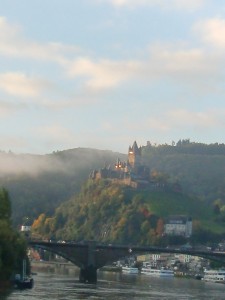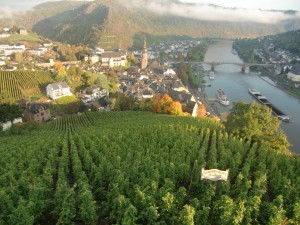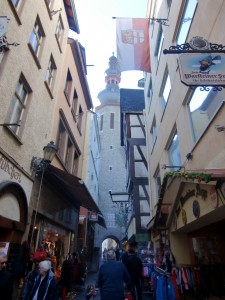CRUISING THE RHINE AND MOSEL RIVERS – A GEM ON THE MOSEL RIVER
CRUISING THE RHINE AND MOSEL RIVERS
This is the fifth in a series of articles about cruising on the Rhine and Mosel rivers
A GEM ON THE MOSEL RIVER
By Charles N. Stevens
Photos by Dolores Seidman
All night long we had traveled along the Mosel River, arriving at Cochem around seven. The morning is clear and crisp, the temperature a chilly 49 degrees. In the shadows of early morning, the lights of Cochem seem especially bright, the abrupt hills rising behind the town still dark. About a mile away from where we dock stands the Reichsburg Castle, perched high on a hill, vineyards skirting the slopes below it. On the other side of the river are wooded hills with many fine homes that must afford spectacular views of the city and the valley. Swans, always looking regal, welcome us to the city.
Our first tour of the day is a short trip to the Reichsburg Castle. Small vans transport us up steep winding roads to its entrance. From this height we have a most magnificent view of the valley with the Mosel River running through it, vineyards clinging to the hillsides and the picturesque town below. For a long time we drink in the beauty of this scene, the leaves in the vineyard below us rustling in a cool breeze.
The towers and turrets capped with conical “dunce cap” roofs as well as most of the structures are built of gray slate, a sturdy construction that has kept most of it standing all these years. The original castle was built in 1130 but was overrun by French troops in 1688 that left it partially in ruins. It was restored in 1832 and is presently owned by the city of Cochem. It is a “working” castle and is used for tours, medieval banquets, gourmet festivals and wine events.
We walk through many of the castle rooms, most decorated as they might have been in medieval times. We amble through gothic arches from one room to the next, looking at great fire places, Dutch tiles, painted portraits, antique furniture, a bed room with an escape route, hunting spears and even polished knight’s armor.
From the castle, we walk down the hill, passing through a well-kept cemetery colorful with flowers, through a stone gate and down narrow cobbled streets lined with houses dating from the 16th century. Blessings were over one door of a house built in 1704. At last we arrive at a plaza paved with flat stones. We look up at the pleasing half-timbered architecture of the Rathaus and the peaked roofs of quaint five-story buildings as we stroll through town. I can’t help pausing at a bakery and peering in the window at their gorgeous cakes and strudels, their twirls of meringue. The door handle is in the shape of a giant pretzel.
Continuing down the narrow street, we pass through the arch of the church tower, the church bells clanging. Sausages and schnitzel hang in a shop, their tempting scent drifting out to the street. Shops selling wine, ice cream and sandwiches are doing a good business.
At noontime we walk over a bridge spanning the Mosel River. A gentle breeze blows down the river, rustling flags, the sky clear. From here we look back at the town, the river, the green hills and vineyards, all burnished by the sun, a scene that is the most memorable of our trip; breathtaking.
After lunch Dolores and I stroll along the edge of the river, stopping briefly to watch workers picking grapes on a steep hillside. A long pipe descends the hill among the vines. Workers at the top insert grapes clusters into it. They slide down inside, then empty at the bottom with a whispering sound, then plop into a metal bin. We peek over the side to see the hundreds of pounds of green grapes nestled in it. Quite a sight!
Our boat leaves Cochem in late afternoon, still heading up the river. Vineyards cover the slopes of the hillsides on both sides except where gray slate outcrops prevent it. Trees soften the banks of the river. Cruising slowly down the river, watching the scenes pass by, is so restful and pleasurable. Sometimes there are large signs in the vineyards denoting who owns them. Tracks run down some slopes for bins on wheels to carry the grapes to the bottom. We pass grassy campgrounds where many trailers with pop-out tents are lined up, people enjoying the outdoors.
Small, picturesque towns appear now and then, all of them looking like the lighted houses one displays at Christmas time. The ruins of a castle, now only a ragged pile of stones, top one hill.
After dinner, as night falls, we see only the occasional lights of towns or softly illuminated visions of church towers. Then it is time to sum up the day, read a good book and contemplate a good night’s sleep.

The Reichsburg Castle, high up on the hill, dominates the skyline above Cochem.

This view from the castle, looking down on the river and town, was one of the great sights of the trip.

Walking down through Cochem is like strolling through history, the bells chiming above the church arch.

One can't help but pause at a bakery window, the cakes being a work of art.
MONTEREY PARK AUTHOR PUBLISHES 3RD BOOK ABOUT HIS EXPERIENCES IN WORLD WAR II- BACK FROM COMBAT
Charles “Norm” Stevens, a 40 year resident of Monterey Park and World War II Veteran has recently published the 3rd in his series about his experiences in WW II, Back from Combat: A WWII Bombardier Faces His Military Future. This book details the time from when he returned from combat in England where he flew 34 missions over Germany and France until the end of the war. Faced with large numbers of returning combat vets, and not knowing how long the war would continue, the military had to plan for their future. His options were whether to return to combat, become an instructor in the U.S., or receive new training that he would use in the Pacific. The book concludes with the end of the war with an Afterward that includes an update on the B-l7’s still flying in the U.S., as well as present day accounts pertaining to the war.
Stevens is the author of two previous books about his experiences:
An Innocent at Polebrook: A Memoir of an 8th Air Force Bombardier (Story of his 34 bombing missions from his base at Polebrook, England over Germany and France)
The Innocent Cadet: Becoming A World War II Bombardier (A prequel to the first, telling of his training in the U.S. before going overseas into combat.)
He is known to the readers of The Citizen’s Voice as the author of Travel Log Articles including “From Paris to Normandy on the Seine”, “Exploring New York” and “In Search of Snow.” He is retired, having taught for 32 years, primarily in the Montebello Unified School District.
Those interested in purchasing an autographed copy of any of his books, may contact the author at 323-721-8230 or Normstevens24@gmail.com



